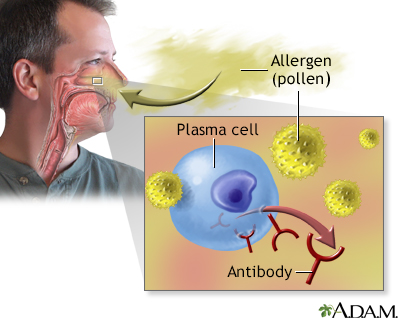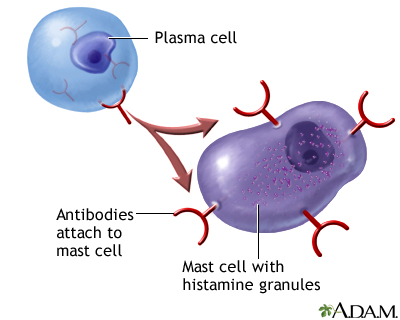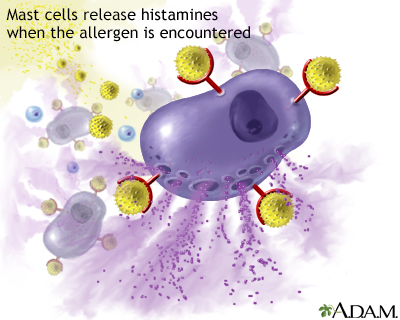| Step 2: The role of the immune system |
An allergic reaction occurs after your body becomes sensitized (develops an allergic antibody IgE) to an offending substance -- such as ragweed pollen, dust mites, or cat dander. All of these substances are called "allergens." In the four stages of an allergic reaction described below, ragweed pollen will be used as an example of how your immune system might react when an allergen gets into the body.
The body recognizes an intruder
The first time you breathe in ragweed pollen, your body identifies the pollen as a foreign, invading substance. Certain types of white blood cells, such as dendritic cells, "eat" the pollen, then travel to a nearby lymph node. In the lymph node, these cells connect to other white blood cells, called lymphocytes. In time, your body activates some of the lymphocytes, called B-cells, to make an allergic antibody (IgE) against the ragweed pollen. You will not have symptoms of an allergic reaction the first time that your body makes IgE to a substance.

The body gets ready
The IgE antibodies to ragweed pollen attach themselves to mast cells (which are located in tissue that lines the nose, bronchial tubes, as well as the gastrointestinal tract and the skin) and basophils (cells which circulate around in the bloodstream). The antibodies stick out from the surface of the mast cells and basophils, waiting. Your body is now "primed" and ready for any time in the future when ragweed pollen enters the body.

The attack
The next time you breathe in ragweed pollen, the antibodies "grab" the pollen and send a signal down to the attached mast cells and basophils. Powerful chemicals are immediately released -- including histamine, heparin, and over 30 others. They cause the nearby tissue to become swollen and inflamed. Histamine causes many of the familiar symptoms of an allergic reaction, such as runny nose, sneezing, and itching.

The delayed response
Some people also will experience what is known as the "late phase" of an allergic reaction. This occurs because the chemicals associated with the reaction attract additional types of immune cells to the site of the allergic reaction, such as eosinophils, neutrophils, and lymphocytes. These cells, in turn, release chemicals which can actually cause tissue damage. The late phase can occur between 4 and 6 hours after exposure.
 |
Reviewed By: Paula J. Busse, MD, Assistant Professor of Medicine, Division of Clinical Immunology, Mount Sinai School of Medicine, New York, NY, Review provided by VeriMed Healthcare Network. Also reviewed by David Zieve, MD, MHA, Medical Director, A.D.A.M., Inc.
